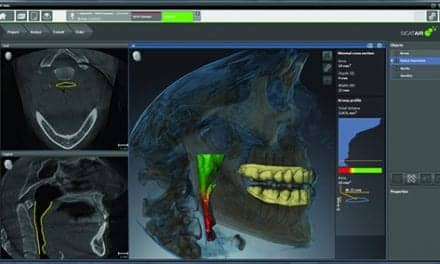DISE can be a one-stop shop to identify collapsible areas.
By Sree Roy
Dental sleep medicine practitioners seek a balance between an oral appliance mandibular advancement degree that creates improvement in a patient’s obstructive sleep apnea symptoms and too much advancement that can lead to unnecessary side effects. Recently, studies have shown some patients to achieve effective therapy at protrusive distances less than 70%, and “I, too, observed similar outcomes in my clinical practice, [so] I wanted to explore this further,” says Harmeet K. Chiang, DDS, MS, FAGD.
She and co-investigators at the Virginia Commonwealth University Health System decided to find 25 patients with obstructive sleep apnea (OSA) who are candidates for oral appliance therapy and see if drug induced sleep endoscopy (DISE) could select the optimal mandibular advancement level for predicting a successful outcome. Four patients have been studied so far and all showed some improvement in their airway collapse at a mandibular advancement less than 70%. The American Academy of Dental Sleep Medicine (AADSM) awarded the resulting abstract a Clinical Excellence Award for 2020 and published it in the April 2020 edition of the Journal of Dental Sleep Medicine.
“Unfortunately, and despite 35 years of research, there is still no cost-effective consistent way to accurately predict oral appliance outcomes or adherence on an individual basis,” Chiang says.
“There are other methods like a multi-sensor airway physiology study to quantify pcrit [upper airway collapsibility] but it is invasive and at times not clinically applicable. Remote controlled mandibular protrusion sleep studies, also known as MATRx, have shown good to excellent response and are very popular; however, if we account for the inconclusive test results then the predictive response is potentially poor.”
Related: How to Predict Oral Appliance Outcomes
DISE in sedated patients with OSA is Chiang’s preferred technique for revealing anatomic and dynamic collapsible areas. “This not only helps me identify if this patient is a candidate for an oral appliance, who may have previously been over or under-titrated, but as DISE reveals anatomic and dynamic collapsible areas an evaluation for all treatment options (CPAP, surgical options, hypoglossal nerve stimulation) may be made based on the aspect of obstruction level, severity, and multiplicity,” she says. “It can be a one stop-shop.”
Surprisingly, the study found that in some cases more mandibular advancement actually caused the airway collapse to be worse than with less mandibular advancement, and science does not currently understand why. Chiang says, “Further studies of the dose-dependent effects of mandibular advancement on other pathophysiological traits contributing to OSA may clarify the sources of variability in response to this treatment modality, with the ultimate goal of developing personalized approaches to patient selection.”
Sree Roy is editor of Sleep Review.
Reference
Chiang H, Bauschard M, Nord R. Mandibular advancement during DISE may identify the optimal advancement position for oral appliance success: pilot study. JDSM. 10 Apr 2020;7.2:Abstract #006.





